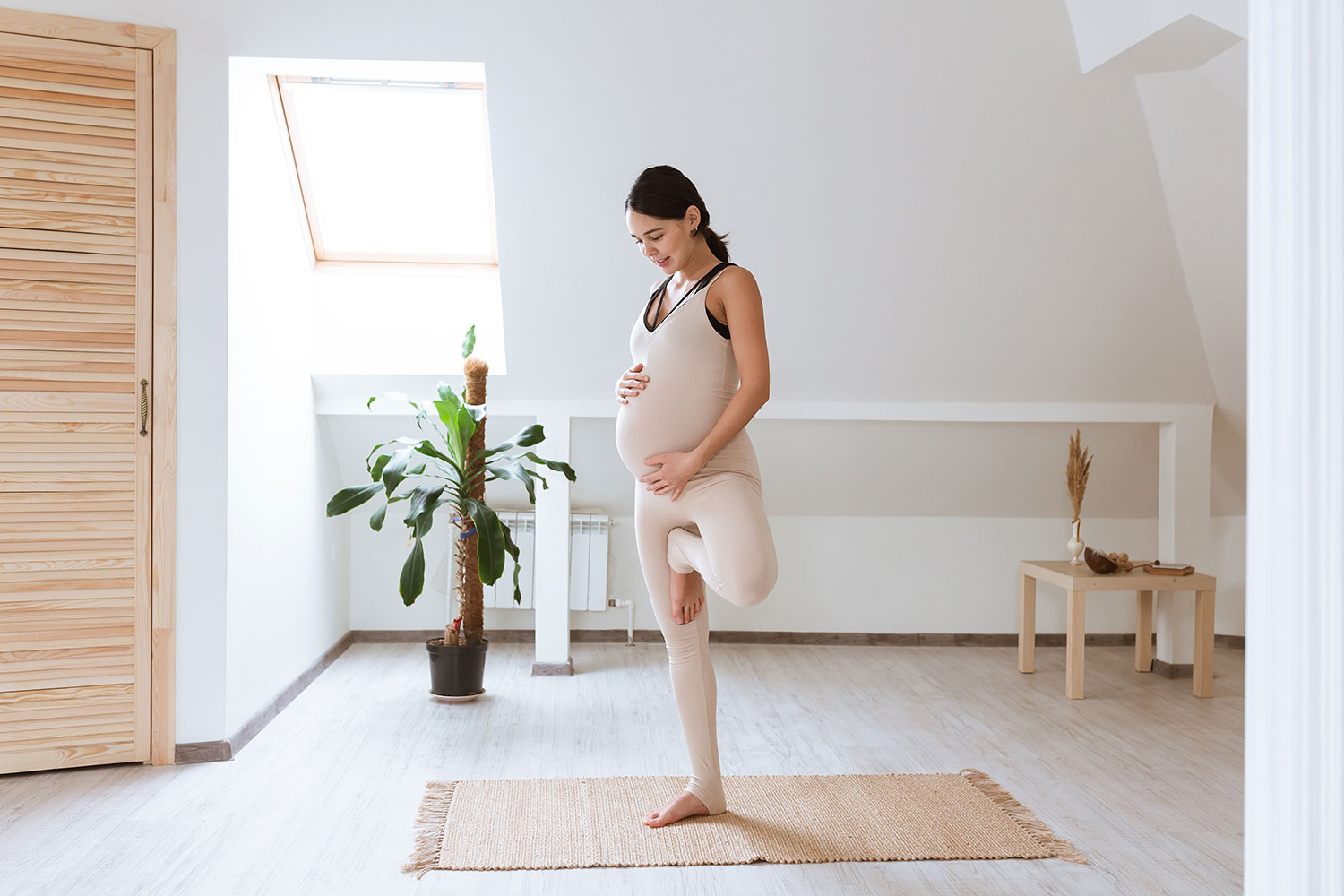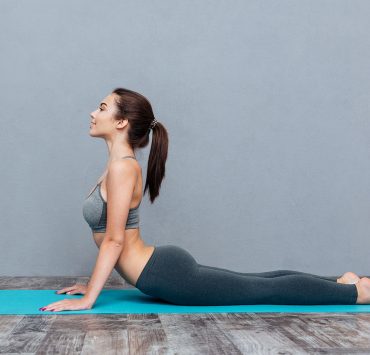
After spending nearly two decades as a relationship therapist, Patricia…
You’ve probably heard that certain exercises during pregnancy are good for you and can help alleviate some less-than-desirable symptoms like constipation, back pain, bloating, swelling and fatigue. Not to mention, staying active provides mental support for expecting women by increasing energy, lifting spirits, and improving sleep. If you’re pregnant and looking for a way to stay fit without creating stress, prenatal yoga might be just what you need.
What Is Prenatal Yoga?
During pregnancy, the body goes through a whirlwind of changes, which leads to stress both mentally and physically. Prenatal yoga is an effective method for managing these inevitable shifts by caring for body and mind. This form of yoga, structured similarly to other yoga classes, focuses on safe postures for pregnant women that will increase their strength and flexibility while helping them develop proper breathing and relaxation techniques. It incorporates accessible poses and ample modifications to make sure the mother is safe and comfortable. In addition to alleviating pregnancy symptoms, a consistent prenatal yoga practice can help encourage health in labor and postpartum.
When Should I Start Prenatal Yoga?

Whether you’re trying to conceive or already pregnant, yoga can play a huge part in your ability to conceive and have a healthy pregnancy. Don’t have a consistent yoga practice? No problem! You don’t have to be a skilled yogi to start practicing prenatal yoga. As long as your doctor says it’s safe, you’re good to go! Yoga is an ideal form of exercise for expectant and hopeful moms – It’s gentle and restorative while still offering some challenge when desired.
How Does Yoga Benefit Mother And Baby?

- Improves focused breathing and mental awareness
- Reduces restlessness
- It helps deepen the connection between mother and baby
- Alleviates stress and anxiety
- Enforces relaxation techniques for labor
- Develops strength, flexibility, and endurance
- Helps position the pelvis for childbirth
- Decreases back pain and headaches
- Helps with nausea
- Reduces the risk of preterm labor and intrauterine growth restriction
- Lowers blood pressure and heart rate
- Stabilizes moods
- Manages weight gain
How Does Prenatal Yoga Help With Birth?
Prenatal yoga can significantly influence your delivery experience by giving you the tools needed to manage overwhelming pain and emotions. The various breathing exercises practiced in yoga play an essential role in keeping both mother and baby calm during labor and delivery. The strength and flexibility brought on by yoga can improve your ability to push the baby out effectively and recover quickly from birth.
Top 10 Prenatal Yoga Poses:
Parighasana — Gate Pose

Benefits:
- Promotes healthy digestion
- Stretches pelvis, chest, and side body
How To:
- Start kneeling and extend one leg straight to the side with the foot flat
- Inhale both arms overhead
- As you exhale, slide the arm that is on the same side as the straight leg down the leg
- Extend the other arm up and over as you rotate the chest towards the ceiling
- Inhale back through center and switch sides
Marjaryasana — Cat/Cow Pose

Benefits:
- Increases spinal strength and flexibility
- Relieves back tension
- Helps move the baby into a favorable position for birth
How To:
- Begin on all fours with hands directly under shoulders and knees directly under hips
- As you inhale, shift your gaze up and drop your belly towards the floor
- As you exhale, round your spine and draw the chin towards your chest
- Repeat this motion at least five times
Baddha Konasana — Cobbler’s Pose

Benefits:
- Stretches hips, thighs, and knees
- Prepares body for childbirth
How To:
- Find a comfortable seat with a tall spine, using a wall or bolster as needed
- Bend your knees and bring the soles of the feet together
- Gently guide your knees towards the floor, using blocks or pillows for support if needed
- Bring your feet as close to the sit bones as possible
- Root down through the outside edges of the feet and support them with your hands
Virabhadrasana II — Warrior II Pose

Benefits:
- Increases leg strength
- Opens groins
- Deep hip opener
- Increases fertility
- Alleviates backaches
How To:
- Start standing at the head of your mat
- Take a wide step back with one foot
- Turn the back foot out, aligning the front heel with the back arch
- Inhale the arms out in a T-shape
- Exhale and bend deeply into the front knee, stacking knee over ankle
- Gaze beyond the front fingertips
- Keep the spine straight and shoulders stacked over hips
- Inhale to straighten the front leg and repeat on the other side
Viparita Karani — Legs Up The Wall Pose

Benefits:
- Relieves swollen feet
- Soothes tired legs
- Reduces pressure on the sacrum
- Regulates circulation
How To:
- If using, place a bolster against the wall, or further if needed
- Kneel with your back to the wall
- Move one hip up onto the bolster (if using) as you extend the same side arm forward
- Roll yourself onto the bolster as you lift the legs up the wall
- Adjust the hips forward or back as necessary
- Stay here for 5 minutes or longer
- Slowly come out the same way you came in
Malasana — Yoga Squat Pose

Benefits:
- Stretches ankles, groins, and back
- Tones the belly
- Prepares the body for birth
- Lengthens muscles of the pelvic floor
How To:
- Stand with feet roughly mat’s width apart
- Bend the knees and lower down into a squat
- Keep the spine long
- Allow the toes to turn out slightly
- Bring the hands together at heart center
- Use the elbows to encourage the knees to open
- Stay for at least five breaths before straightening the legs to come out
Balasana — Child’s Pose

Benefits:
- Relieves nausea
- Combats stress and anxiety
- Soothes tension in the back and hips
- Calms the mind
How To:
- From a kneeling position, bring the knees wide and big toes together
- If using a bolster, place it directly in front of you
- Begin to reach the hands forward
- Let the upper body rest on a bolster or bring the forehead down to the floor or a block
- Stay for as long as you need before slowly coming back to a kneeling position
Upavistha Konasana — Wide-Angle Seated Forward Bend Pose

Benefits:
- Opens the hips
- Stretches the back and thighs
- Relieves belly weight
How To:
- Find a comfortable seat with legs straight and separated as much as is comfortable
- If needed, place a bolster between the legs
- Inhale the spine long
- Exhale and slowly walk your hands out in front of you, bringing your torso down to any level
- Let the bolster support you as you relax into this shape
- Hold for at least five breaths before slowly coming back upright
Ashwa Sanchalasana — Low Lunge Pose

Benefits:
- Loosens hip flexors and psoas
- Creates space in the spine
- Opens front body
How To:
- Starting on all fours, step one leg forward so the knee is directly over the ankle
- You may need to take your front foot towards the edge of the mat to accommodate your belly
- Tuck your back toes under
- Avoid overarching in your lower back by lengthening the tailbone down
- Keep your chest open
- Reach your arms overhead or rest both hands on the front thigh
- Stay for 5 breaths before coming back to hands and knees and repeating on the other side.
Matsyasana — Supported Fish Pose

Benefits:
- Provides full-body relief
- Opens the hips and heart
- Calms the mind
How To:
- Find a comfortable seat
- Using two yoga blocks, place one yoga block behind you on the lowest height
- Place the other block a few inches behind that one on the middle or highest height
- Slowly lower down so your mid-back rests on the first block and your head rests on the second block
- Bend the knees and bring the soles of the feet together or extend the legs straight
- Allow the arms to rest by your sides
- Stay for as long as you’d like before carefully making your way out using the support of your arms
Best Online Prenatal Yoga Resources
- Prenatal & Postnatal Yoga Videos on Gaia
- Rachel Brathen’s Prenatal Yoga Classes on OneOEight
- Prenatal Yoga Center Online Videos
- Pregnancy Yoga with Tara Lee on Amazon Prime Video
- Prenatal Yoga on Alo Moves
- Prenatal Yoga, Safe Gentle Stretches on Amazon Prime Video
- Prenatal Yoga on Yoga With Adriene
- Prenatal Yoga Squats by Gigi Yogini
- Prenatal Yoga Videos & Classes on Power Yoga
- Prenatal Routine with Laura Dutta
- Katy Appleton Pregnancy Yoga Videos on YouTube
Postnatal Yoga

So you’ve just had a baby – Now what? Postpartum comes with its own set of physical and mental hurdles that yoga can help us navigate. Once approved by your doctor, simple yoga postures guide us toward total body restoration and recovery. For the new mother, positions that address her weakened pelvic floor and abdominal muscles, aching neck and shoulders, fatigue, and lack of endurance are key. For the little bundle of joy (yes, yoga is for babies too!), yoga can aid in soothing colic caused by an upset tummy.
Yoga For Infertility
Many are looking to yoga as a safe, practical approach to infertility. This is in part because stress plays a significant role in the struggle to conceive and yoga helps reduce unnecessary physical and mental strain. Yoga helps increase fertility by inducing relaxation and restoring what may be a tumultuous relationship to the body. Partner yoga also comes recommended to couples who are trying to conceive as it brings them together in a non-sexual, supportive way.
A Word Of Caution

Although yoga is an exceptionally safe form of exercise for pregnant women, there are a few golden rules that should be followed:
- Keep body temperature at a comfortable level
- Avoid dehydration
- Do not lie on your back for long periods
- Avoid overstretching the muscles due to relaxin hormones
- Be mindful of changes to your center gravity during standing balance postures
- Avoid elevating the heart rate too high by staying cognizant of the breath
- Stay away from deep bends and twists
- Don’t hold your breath
- Listen to your body when it comes to inversions
What's Your Reaction?
After spending nearly two decades as a relationship therapist, Patricia journeyed down the path of writing as a vehicle for sharing her wisdom. Her work reflects a sincere interest in readers’ wellbeing and is abundant with helpful advice and fascinating insight.














